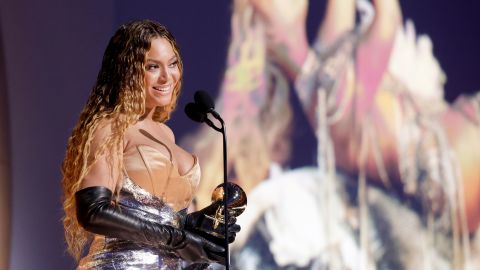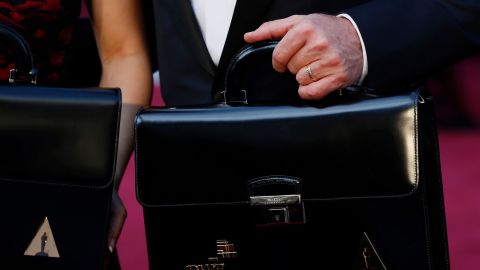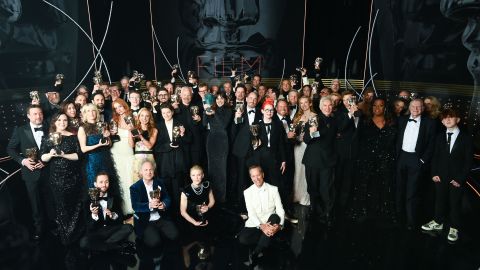CNN —
Year after year, the conversation surrounding mainstream awards shows is the same: Where’s the diversity?
Even in a record-setting year like 2023 – which has so far seen Beyoncé become the most awarded artist in Grammy history and features the most Asian nominees in a single year at the Oscars – questions about these shows’ commitment to equity persist.
Many have criticized this year’s Academy Awards – which takes place Sunday – for failing to recognize to recognize Black female talent. The Grammys snubbed Beyoncé for its heralded album of the year award, instead awarding Harry Styles, in a move that stunned fans and critics alike. And at the BAFTAS, essentially the UK’s Oscars, every winner this year was White.
These mainstream awards are often coveted both for economic gain and industry clout. But even as the public puts pressure on the entertainment industry to increase diversity, some have argued only incremental changes have been made.
“We see more (changes) because they don’t want to be criticized anymore,” said Nancy Wang Yuen, sociologist and author of “Reel Inequality: Hollywood Actors and Racism,” speaking specifically of the Oscars. “But the kinds of changes they’ve been making have all been more in name only.”
One of the issues facing mainstream awards is simply how much harder it is for people of color to receive recognition.
The last time a woman of color won best actress at the Academy Awards was in 2002, when Halle Berry nabbed the prize for her role in “Monster’s Ball” and became the first Black woman to ever take home the honor. In her acceptance speech, Berry dedicated her win to past and present Black actresses, as well as “every nameless, faceless woman of color that now has a chance because this door tonight has been opened.”
And yet that hasn’t been the case. Not including this year’s nominees, only nine women of color have been nominated for the prize since Berry’s win and none have won. Meanwhile other actresses, like Frances McDormand, have won the award twice in the same amount of time.
This year, Michelle Yeoh – one of the most famous actresses in the world – is nominated for her first Oscar. And if she’s declared best actress Sunday, she’ll make history as the first Asian winner in that category. It took her decades for her to receive the recognition of a nomination, and looking ahead to her upcoming roles, Yuen pointed out that Yeoh, for the most part, is still not playing the lead.

Yeoh has been vocal about the disparity Asian actors face. During a roundtable in December, she spoke about the difficulty older women have receiving interesting roles, citing her own experience as an Asian woman.
“I honestly look at all of you with such envy because you get an opportunity to try all the different roles,” Yeoh said at the time. “But we only get that opportunity maybe once in a long, long time.”
If one of the most famous Asian actresses in the world is struggling, Yuen said, how much harder must it be for other actors and actresses of color? What Berry and Yeoh have faced is proof of just how flawed the system is, she noted.
“Even the awards themselves are not enough to overcome the structural racism and sexism that women of color face in Hollywood,” Yuen said.
But the barriers against people of color can be found throughout the entertainment industry – not just in film.
Jasmine Henry, a professor of music at the University of Pennsylvania, used Beyoncé as an example. Despite becoming one of the most awarded artists at the Grammys, her rate of actually winning compared to the amount of times she’s been nominated is actually less than other artists.
Though Beyoncé has won 32 times and received 88 nominations, Adele, for example, has won 16 times while only being nominated 25 times – giving Adele a higher win rate. Adele has also won album of the year twice, from three nominations, whereas Beyoncé has been nominated in the category four times and has never won.

“(The Grammys) honor Black artists, but just enough to say that they did honor them,” Henry said. “Not enough to truly produce equitable results.”
And many Black artists and artists of color are put in a R&B or rap music box, Henry said, thus limiting the categories in which they can get nominated and win.
Drake has been vocal about this. In 2017, when his hit “Hotline Bling,” a song on which he mostly sings, won best rap song and best rap performance, Drake explicitly noted that the track was not a rap song.
“The only category that they can manage to fit me in is in a rap category,” Drake said in an interview following the awards. “Maybe because I’ve rapped in the past, or because I’m Black.”
As for why these mainstream awards are slow to reward and recognize diverse talent, the answer is often in the awards bodies themselves.
These institutions are typically legacy institutions, Henry said, meaning that those who have participated in the system and industry are the ones who get voting rights. For a long time, in many parts of the entertainment industry, that meant voters were often White men.
Today, most mainstream awards shows are relatively secretive about who decides the nominees and winners for each category. Still, many theorize that their voter demographics have barely changed.
Though the Recording Academy, which presents the Grammys, has made efforts to increase minority representation in its recent classes, Henry said the organization is still believed to be predominantly male and White.
The Academy of Motion Picture Arts and Sciences isn’t any better. The Academy does not publicly give demographic specifics on its voters, but a 2016 study by the Los Angeles Times found that 91% of voters were White and 76% were male. Though the Academy has also attempted to increase diversity among its ranks by electing more women and people of color to its board of governors, more recent estimates show the organization is still composed of mostly White people and men.
When the voting bodies are relatively homogenous, it affects what, and who, they find worthy of nominating, explained film critic Robert Daniels. Older White voters may be unconsciously gravitating toward stories they find relatable, which are not always the most diverse narratives.
“Most say they vote on what they like, but of course we have to inspect why do they like this,” Daniels said.

With many of the public pushes towards more diversity at awards shows, such as the #OscarsSoWhite campaign in 2015, many voters are also probably aware of the need for more diverse nominations, Daniels said, and may therefore nominate one or two people of color.
But one or two is still an incremental amount. The idea that most of the nominees, or even all of them, could be people of color, Daniels said, is not one most voters may be considering. Instead, they may look to simply check a diversity box with their nominations.
Studios are also going to put the most money behind the films they believe have the best chance of earning a nomination, Yuen said, which inherently means catering to the tastes of the voters.
“People are going to put a lot of money behind Tom Cruise because they believe in him,” Yuen explained.
But for stories featuring minorities, she said, that may not be the case.
Awards shows have, however, made some strides in recognizing minority stories.
Historically, Asian actors in Asian-led films haven’t been recognized for individual acting Oscars, Yuen said – even if the movies themselves receive awards.
She cited 2008’s “Slumdog Millionaire,” 2000’s “Crouching Tiger, Hidden Dragon” and 2019’s “Parasite,” all of which were nominated for Oscars in multiple categories, including best picture, but saw zero nominations for any of the actors involved.
This year is different. “Everything Everywhere all at Once” has been nominated for multiple categories, and is a favorite to win best picture. And the three main actors in the film – Stephanie Hsu, Ke Huy Quan and Michelle Yeoh – have all been nominated in individual acting categories, too.
“(The Oscars are) finally recognizing Asian bodies, not just Asian stories,” Yuen said. “There are Asian subjects, actors, talent, who are actually embodying these roles and doing it just as well as any other actor that is typically nominated.”
The issue of representation isn’t just limited to awards shows, Daniels said. The entire entertainment industry – including critics, guilds and studios – needs to change, too.
“We had this reckoning with #OscarsSoWhite and I think one problem … is that we interpreted that it was only the Oscars that are so White,” he said. “Every level needed to become more diverse.”

He pointed to the Gotham Awards as an example. The annual ceremony centers independent filmmakers and has a small, diverse, nominating committee for each category, who watch the eligible films and decide on nominees together, Daniels said. Voting by committee, he said, could help improve diversity at other, larger awards shows, too.
The BAFTAs have incorporated this method to some benefit. In an effort to increase diversity among its nominees, the BAFTAs completely overhauled their process in 2020. As a result, in 2021 and 2022, the majority of nominees for the awards were chosen by smaller juries, rather than solely by votes from British Academy members. The BAFTAs then saw an increase in representation among its nominees – considered a win for the British Academy.
But this year, in 2023, the group walked back some of those changes following criticism, deciding to instead equally split nominations for each category between voters and a jury – meaning both groups chose the same number of nominees.

The nominees were still considered a diverse group. And yet at this year’s awards, all the winners were White, sparking questions about whether the overhaul actually led to concrete change.
“We’re seeing equal opportunities in some cases, but certainly not equal outcomes,” Henry said. “We’re stuck in this cycle of slight progress sometimes, and other times a little bit of regression.”
For lasting impact, Henry said the industry needs to go beyond superficial changes and work to rebalance structural issues and ingrained biases across entertainment.
“By grappling with deeply embedded issues of racism, sexism and homophobia in the industry, that would mean an evaluation of not just the award categories and systems, but record companies, film industries, production practices and an entire industry,” she said. “That’s a scary ball of yarn to try and unravel.”
Until the industry makes broader changes, Henry said, its problems won’t change, either.
.png)
 1 year ago
7
1 year ago
7









 English (US) ·
English (US) ·